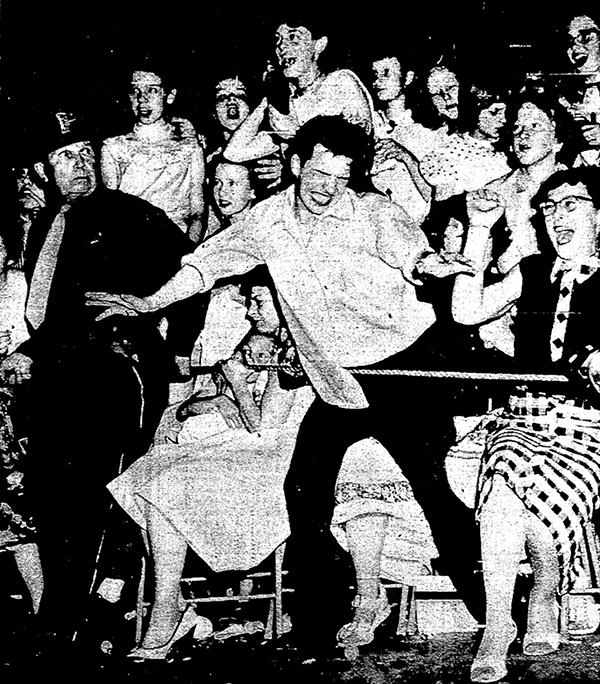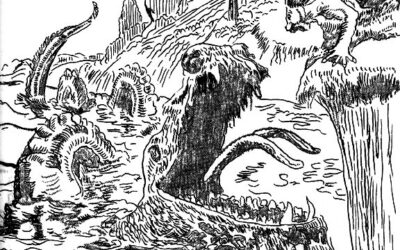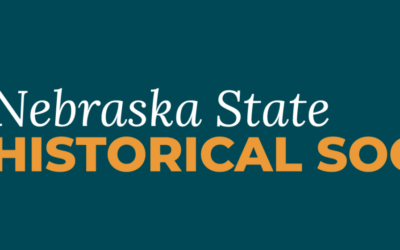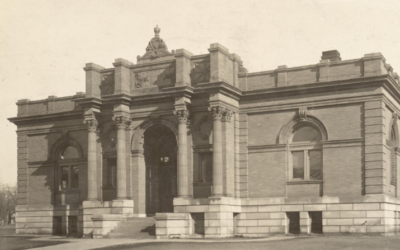Why is this young man all shook up? Elvis Presley performed at the University of Nebraska Coliseum on May 19, 1956, and at the Omaha Civic Auditorium the next day. This photo from the Omaha show appeared on the World-Herald‘s front page.

Why is this young man all shook up? Elvis Presley performed at the University of Nebraska Coliseum on May 19, 1956, and at the Omaha Civic Auditorium the next day. This photo from the Omaha show appeared on the World-Herald‘s front page.
 Backed by a trio, Elvis took to the Omaha stage wearing a bright red coat over a black silk shirt. The reporter noted his long hair and sideburns, and compared his stage moves to a “‘cooch dance, complete with bumps and grinds.”
Backed by a trio, Elvis took to the Omaha stage wearing a bright red coat over a black silk shirt. The reporter noted his long hair and sideburns, and compared his stage moves to a “‘cooch dance, complete with bumps and grinds.”
Nebraskans debated the merits and morality of the shows for days afterward. A big part of it was Elvis’s “gyrations” and their effect upon young women. Omaha police reported that one young woman tried to take her clothes off during the show. The police “halted matters before anyone knew what was happening.”
“What’s happened to our teenagers? Are their morals and standards so low that they have to watch this Elvis Presley perform his downright immoral and filthy actions?” asked the writer of a World-Herald “Public Pulse” letter on May 24.
Another letter writer speculated about the mania: “Is it because youth is not subject to any serious requirements or duties beyond classroom requirements, much of which is of questionable value, resulting in a complete lack of a sense of proportion or values?”
Others defended Elvis:
“True, he has some kind of magic that makes the girls scream. I was one of them and I don’t think it’s anything to be ashamed of,” wrote one young woman.
“Remember Grandma, Rudy Valentino, and the gals who went into hysterics over him. Mom, too,” wrote another person, referring to a screen heartthrob of the silent film era. Another writer asked,
“What are teen-agers expected to do? Sit and listen to Chopin?”
Another issue, not dealt with as openly in Nebraska media, was the music’s racial roots. Whatever the race of the performer, “rock-n-roll” was rooted in black rhythm and blues. Now it was crossing over to white audiences. On the same day as Elvis’s Omaha performance, members of the White Citizens Council in Birmingham, Alabama, picketed a mixed-race rock-n-roll show headlined by Bill Haley and the Comets. “Ask Your Preacher About Jungle Music,” read one of the protesters’ signs. The World-Herald reported the news on page one, right below its report of Elvis’s Omaha show.
Presley returned to Omaha in 1974 and 1977. His show at the Civic Auditorium on June 19, 1977, was one of his final performances. Portions of that show aired as a TV special after his death later that year.
Left: Ad from the Lincoln Star, May 18, 1956. Elvis was billed as the “Nation’s Only Atomic Powered Singer” the same week that the US tested its first air-dropped hydrogen bomb. The 10-megaton warhead was detonated over the Bikini Atoll in the Marshall Islands on May 20.
—David L. Bristow, Editor
(Posted 4/30/2019)




